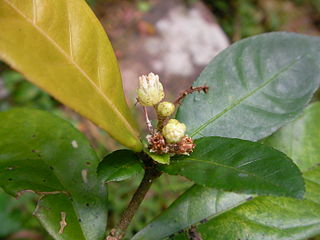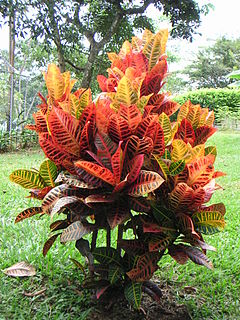
Croton is an extensive flowering plant genus in the spurge family, Euphorbiaceae. The plants of this genus were described and introduced to Europeans by Georg Eberhard Rumphius. The common names for this genus are rushfoil and croton, but the latter also refers to Codiaeum variegatum. The generic name comes from the Greek κρότος, which means "tick" and refers to the shape of the seeds of certain species.

Croton hanceiBenth., the Hong Kong croton, is a shrub or small tree, a species of Croton which is endemic to Tsing Yi Island, Hong Kong. In Hong Kong, it is listed in the book Rare and precious Plants of Hong Kong.

Parkinsonia florida, the blue palo verde, is a species of palo verde native to the Sonoran Deserts in the Southwestern United States and Northwestern Mexico. Its name means "green pole or stick" in Spanish, referring to the green trunk and branches, that perform photosynthesis.

Codiaeum variegatum is a species of plant in the genus Codiaeum, which is a member of the family Euphorbiaceae. It was described by Carl Linnaeus in 1753. It is native to Indonesia, Malaysia, Australia, and the western Pacific Ocean islands, growing in open forests and scrub.

Amelanchier utahensis, the Utah serviceberry, is a shrub or small tree native to western North America. This serviceberry grows in varied habitats, from scrubby open slopes to woodlands and forests.

Croton californicus is a species of croton known by the common name California croton. This plant is native to California, Nevada, Utah, Arizona, and Baja California, where it grows in the deserts and along the coastline.

Croton eluteria, known as cascarilla, is a plant species of the genus Croton that is native to the Caribbean. It has been naturalized in other tropical regions of the Americas. It grows to be a small tree or tall shrub, rarely reaching 20 feet (6 m) in height. Its leaves are scanty, alternate, ovate-lanceolate, averaging 2 inches (5 cm) long, with close scaling below, giving a metallic silver-bronze appearance, and scattered white scales above. The flowers are small, with white petals, and very fragrant, appearing in March and April. The scented bark is fissured, pale yellowish brown, and may be covered in lichen.

Arctostaphylos pajaroensis is a species of manzanita known by the common name Pajaro manzanita. It is endemic to California, where it is known mainly from Monterey County.

Atriplex lentiformis is a species of saltbush.

Lepidospartum squamatum is a species of flowering shrub in the daisy family known by the common names California broomsage and scale broom.

Croton verreauxii known as the green native cascarilla is a small tree or shrub growing in dry rainforest and rainforest margins in eastern Australia.

Pholisma arenarium is a species of flowering plant in the borage family known by several common names, including desert Christmas tree, scaly-stemmed sand plant, and purple sand food. As the name implies, the loaf-like part of the root is edible. It is native to northwestern Mexico, Arizona and southern California, where it grows in many habitat types, including desert, chaparral, and sandy coastal dunes. It is a fleshy perennial herb taking a compact cylindrical or ovate shape up to 20 or 30 centimeters tall above ground, often with part of the stem below the sandy surface. It is a parasitic plant growing on the roots or of various shrubs such as burrobush, Yerba Santa, California croton, rabbitbrush, and ragweeds. As a heterotroph which derives its nutrients from other plants, it lacks chlorophyll and is brownish-gray or whitish in color. There are hairy, glandular, pointed leaves along the surface of the plant. Flowers emerge between them, each roughly one centimeter wide, the rounded corolla lavender to deep or bright purple with a white margin.

Croton sylvaticus is a tree in the family Euphorbiaceae. It is commonly known as the forest fever-berry. These trees are distributed in forests from the east coast of South Africa to Tropical Africa. It grows 7–13 metres (23–43 ft) in height, occasionally up to 30 metres (100 ft), in moist forests, thickets and forest edges at altitudes of 350–1,800 metres (1,100–5,900 ft).

Croton gratissimus, is a tropical African shrub or small tree with corky bark, growing to 8 m and belonging to the family of Euphorbiaceae or spurges. Young twigs are slender and angular and covered in silver and rust-coloured scales.

Lobelia laxiflora is a species of flowering plant in the family Campanulaceae. It is native to the Americas, where it is distributed in South, Central, and North America as far north as Arizona in the United States. It is known by several English-language common names, including Mexican lobelia, Sierra Madre lobelia, Mexican cardinalflower, looseflowers lobelia, and drooping lobelia. In Spanish and Nahuatl it is known as aretitos, acaxóchitl, and chilpanxóchitl. It has gained the Royal Horticultural Society's Award of Garden Merit as an ornamental.

Ambrosia monogyra, the singlewhorl burrobrush, is a North American species of plants in the family Asteraceae.

Bertya opponens is a shrub/tree in the family Euphorbiaceae, native to Australia and found in New South Wales and Queensland. It is found on ridges amongst mallee in shallow soils. It flowers in July and August.

Croton pottsii is a species of plant known by the common name leatherweed. It is native to the southwestern United States and northern Mexico.

Croton alabamensis var. texensis is a variety of Croton alabamensis that is endemic to the state of Texas in the United States. It is commonly known as the Texabama croton.

Xylonagra arborea is a flowering plant endemic to the western side of the Baja California Peninsula. It is a bushy shrub distinguished by showy, scarlet flowers that are attractive to hummingbirds. It is the sole species in the genus Xylonagra, which belongs to the family Onagraceae.



















